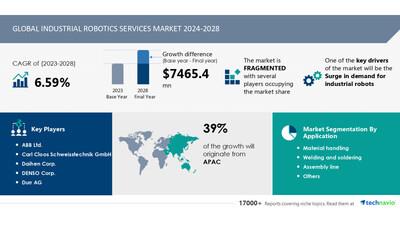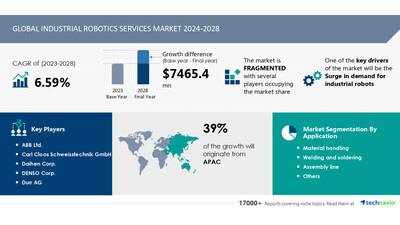
AI's Impact On Industrial Robotics Services Market, Projected Growth Of USD 7.46 Billion (2024-2028) Amid Rising Demand - Technavio Report
| Industrial Robotics Services Market Scope |
|
| Report Coverage |
Details |
| Base year |
2023 |
| Historic period |
2018 - 2022 |
| Forecast period |
2024-2028 |
| Growth momentum & CAGR |
Accelerate at a CAGR of 6.59% |
| Market growth 2024-2028 |
USD 7465.4 million |
| Market structure |
Fragmented |
| YoY growth 2022-2023 (%) |
6.07 |
| Regional analysis |
APAC, Europe, North America, South America, and Middle East and Africa |
| Performing market contribution |
APAC at 39% |
| Key countries |
US, China, Japan, Germany, and South Korea |
| Key companies profiled |
ABB Ltd., Carl Cloos Schweisstechnik GmbH, Daihen Corp., DENSO Corp., Durr AG, FANUC Corp., General Electric Co., Hans Laser Technology Industry Group Co. Ltd., Jenoptik AG, Kawasaki Heavy Industries Ltd., MIDEA Group Co. Ltd., Mitsubishi Electric Corp., NACHI FUJIKOSHI Corp., OMRON Corp., Panasonic Holdings Corp., Seiko Epson Corp., Staubli International AG, Teradyne Inc., Universal Robots AS, and Yaskawa Electric Corp. |
Market Driver
Industrial robotics services are experiencing innovation driven by system integrators leveraging advanced technologies like the Internet of Things (IoT) and software platforms. These solutions primarily enhance commissioning and programming processes. Notable software offerings include ABB's StampSynchro, StampWare, and StampMaster, YASKAWA ELECTRIC's Advanced PP Customization software development kit (SDK), KUKA (Midea Group)'s KUKA, and FANUC's Controller R-30iB. Vendors are also focusing on enhancing robot cell reconfigurability, with offerings like ReconCell, suitable for SMEs producing in small batches. ReconCell integrates force-based control, adaptation capabilities, 3D vision systems, exchangeable grippers, learning, interchangeable sections, and modular frame design. As vendors continue to advance industrial robotics services through simulation, programming, commissioning, and reconfigurability, more end-users will adopt these solutions to boost productivity, thereby fueling market growth during the forecast period.
Industrial robotics is a growing market driven by automation needs across various industries. Key trends include the use of accessories like actuators and communication interfaces for customizability. Agriculture and construction sectors are adopting collaborative robots (cobots) for tasks like harvesting and construction. AI-enabled robots, such as those used in blood sample testing and high-tech testing labs, are revolutionizing industries like healthcare and electronics. Automotive and defense sectors are investing in robots for assembly lines and manufacturing defense equipment. Ground robots are being used in mining and construction. Existing infrastructure in sectors like cosmetics and food processing is being upgraded with robots for improved hygiene and productivity. Digitization and integration of robots with AVs and EVs are also driving growth. Initial capital expenditure can be a hindrance for enterprises, but the long-term benefits of increased efficiency and customizability outweigh the costs. Industrial robotics integrators play a crucial role in implementing factory automation techniques and ensuring seamless integration of hardware and controllers.
Explore a 360° Analysis of the Market: Unveil the Impact of AI. For complete insights- Request Sample!
Market
Challenges
-
Industrial robotics services involve various processes for end-users to deploy robots in their operations. Robot system integration includes contracts, bidding, evaluations, and software solutions for easy integration. Vendors need to invest significantly in system engineering to make the process smoother and reduce costs. Training sessions for operators and staff add to the total cost of ownership. Vendors should innovate to offer cost-effective solutions like virtual commissioning, offline programming, and simulation. High costs remain a significant challenge for the industrial robotics services market growth.
The Industrial Robotics Services Market encompasses various industries such as metals & machinery, pharmaceuticals, rubber & plastic, and more. Robotics solutions are increasingly being adopted for tasks like packaging, production workflows, and even minimally invasive surgeries. Parallel, Scara, and Spherical robots are popular choices due to their payload-carrying capacity and workspace. Technological advancements in robotics include safety features like collision detection and teach pendants for easy programming. However, challenges persist. The production value chain must adapt to integrate robotics, requiring skilled workforce training. Traditional safety barriers in industries like residential sector and retail are being redefined. Robotics is transforming supply chain processes with smart manufacturing and unmanned vehicles. Despite these benefits, troubleshooting and safety concerns remain. Robot arms, vision systems, and mounting bases are essential components. The future of robotics lies in the seamless integration of robotic solutions into various industries, optimizing productivity, speed, and workforce skills.
For more insights on driver and challenges
-
Request a
sample report!
Segment Overview
This industrial robotics services market report extensively covers market segmentation by
-
1.1 Material handling
1.2 Welding and soldering
1.3 Assembly line
1.4 Others
-
2.1 Healthcare and pharmaceuticals
2.2 Automotive
2.3 Food and beverages
2.4 Others
-
3.1 APAC
3.2 Europe
3.3 North America
3.4 South America
3.5 Middle East and Africa
1.1
Material handling-
The Industrial Robotics Services Market is experiencing significant growth due to increasing automation in manufacturing industries . Companies are investing in robotics to enhance productivity, improve quality, and reduce labor costs. Robotics services include installation, integration, maintenance, and training. Leading players in the market offer customized solutions to meet specific industry requirements. The market is expected to continue expanding as more businesses adopt automation to stay competitive.
For more information on market segmentation with geographical analysis including forecast (2024-2028) and historic data (2017-2021) - Download a Sample Report
Research Analysis
The Industrial Robotics Services Market is experiencing significant growth due to the increasing adoption of advanced robotic technologies in manufacturing and production processes. Collaborative robots, also known as cobots, are gaining popularity for their ability to work alongside human operators in shared workspaces. AI-enabled robots are revolutionizing industries by enabling automation and improving efficiency. Climate change is driving the demand for robotics in industries seeking to reduce labor wages and increase productivity. Hardware components such as robot arms, end effectors, vision systems, and IoT-based devices are essential for the functioning of industrial robots. Manipulator robots, equipped with safety features, are replacing traditional safety barriers in dedicated robot zones. Service robots are being used in professional and personal applications, from manufacturing to medical fields. Industrial robots come in various forms, from large manipulator robots to small collaborative robots. Actuators power the movement of these robots, while vision systems enable them to perceive and interact with their environment. The integration of Artificial Intelligence (AI) and collaborative capabilities is transforming the industrial robotics landscape, making human-robot collaboration safer and more efficient.
Market Research Overview
Industrial robotics is a dynamic and evolving market that encompasses various robotic solutions for automation in diverse industries. These robots include articulated, Cartesian, cylindrical, delta, gantry, parallel, and polar types, each designed for specific applications. Accessories such as actuators, communication interfaces, controllers, and mounting bases play crucial roles in their functionality. Industrial robots are increasingly being adopted in sectors like manufacturing, electrical & electronics, machinery, metals & machinery, automotive, defense, food-grade, pharmaceuticals, and agriculture. Robots are used for tasks like assembly, material handling, machine tending, loading and unloading, and packaging. Advancements in Artificial Intelligence (AI), IoT-based devices, and customizability have expanded robot applications. AI-enabled robots are now used in high-tech testing labs, medical, and logistics industries. Collaborative robots (cobots) are gaining popularity due to their ability to work alongside human operators, enhancing productivity and reducing labor wages. The agricultural sector is witnessing the integration of robots for tasks like crop monitoring, harvesting, and livestock care. Robots are also being used in the construction & demolition industry for tasks like bricklaying and debris removal. The production value chain is undergoing digitization, with robots being used to streamline production workflows and increase productivity. The initial capital expenditure for industrial robotics can be a hindrance for enterprises, but the long-term benefits in terms of productivity and efficiency make it a worthwhile investment. Robots are being used in various industries, from manufacturing to medical, to enhance productivity and streamline processes. From assembly lines to medical labs, robots are transforming the way we work. With advancements in technology, the possibilities for industrial robotics are endless.
Table of Contents:
1 Executive Summary
2 Market Landscape
3 Market Sizing
4 Historic Market Size
5 Five Forces Analysis
6 Market Segmentation
-
Application
-
Material Handling
Welding And Soldering
Assembly Line
Others
-
Healthcare And Pharmaceuticals
Automotive
Food And Beverages
Others
-
APAC
Europe
North America
South America
Middle East And Africa
7 Customer Landscape
8 Geographic Landscape
9 Drivers, Challenges, and Trends
10 Company Landscape
11 Company Analysis
12 Appendix
About Technavio
Technavio is a leading global technology research and advisory company. Their research and analysis focuses on emerging market trends and provides actionable insights to help businesses identify market opportunities and develop effective strategies to optimize their market positions.
With over 500 specialized analysts, Technavio's report library consists of more than 17,000 reports and counting, covering 800 technologies, spanning across 50 countries. Their client base consists of enterprises of all sizes, including more than 100 Fortune 500 companies. This growing client base relies on Technavio's comprehensive coverage, extensive research, and actionable market insights to identify opportunities in existing and potential markets and assess their competitive positions within changing market scenarios.
Contacts
Technavio Research
Jesse Maida
Media & Marketing Executive
US: +1 844 364 1100
UK: +44 203 893 3200
Email:
[email protected]
Website:
SOURCE Technavio

Legal Disclaimer:
MENAFN provides the
information “as is” without warranty of any kind. We do not accept
any responsibility or liability for the accuracy, content, images,
videos, licenses, completeness, legality, or reliability of the information
contained in this article. If you have any complaints or copyright
issues related to this article, kindly contact the provider above.



















Comments
No comment